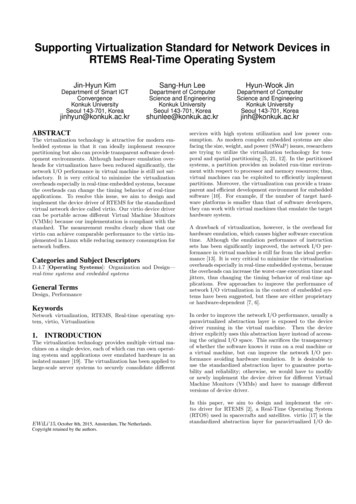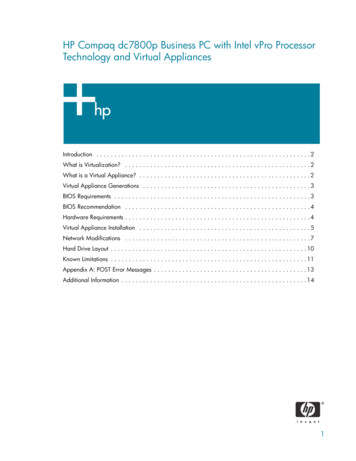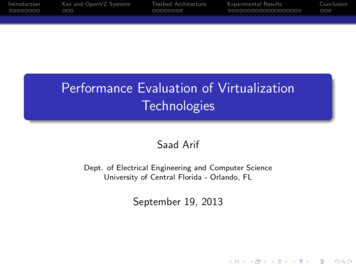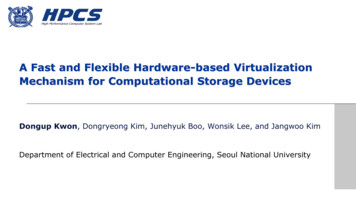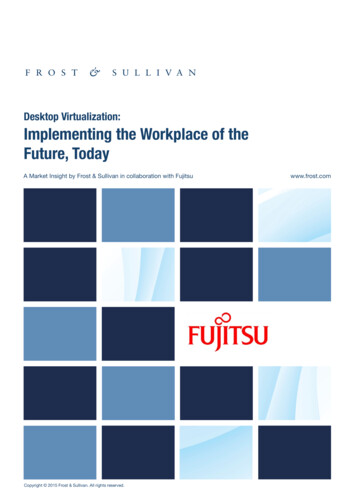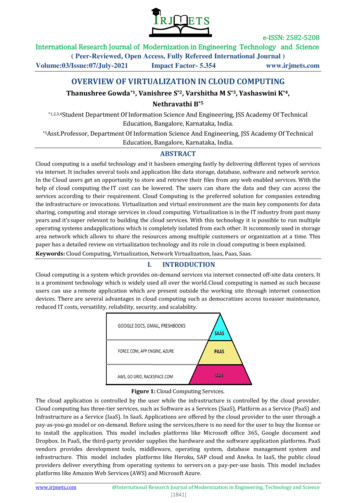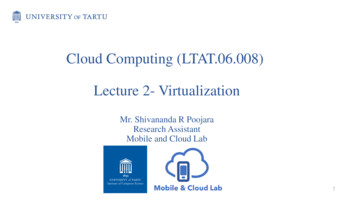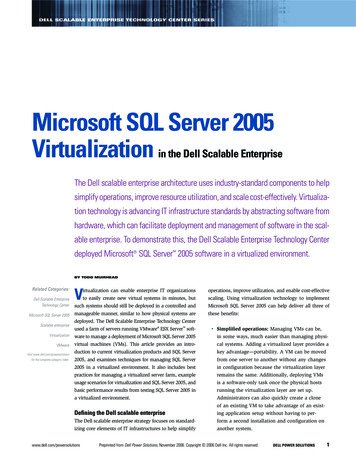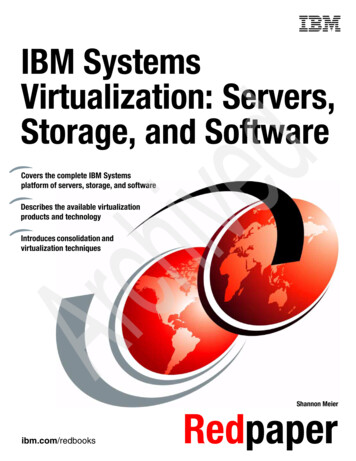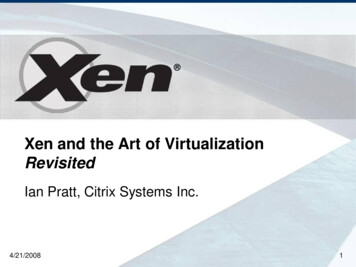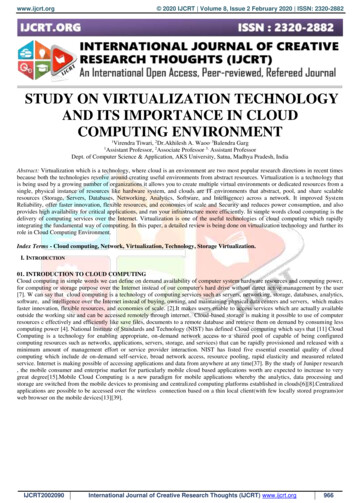
Transcription
www.ijcrt.org 2020 IJCRT Volume 8, Issue 2 February 2020 ISSN: 2320-2882STUDY ON VIRTUALIZATION TECHNOLOGYAND ITS IMPORTANCE IN CLOUDCOMPUTING ENVIRONMENT1Virendra Tiwari, 2Dr.Akhilesh A. Waoo, 3Balendra GargAssistant Professor, 2Associate Professor 3, Assistant ProfessorDept. of Computer Science & Application, AKS University, Satna, Madhya Pradesh, India1Abstract: Virtualization which is a technology, where cloud is an environment are two most popular research directions in recent timesbecause both the technologies revolve around creating useful environments from abstract resources. Virtualization is a technology thatis being used by a growing number of organizations it allows you to create multiple virtual environments or dedicated resources from asingle, physical instance of resources like hardware system, and clouds are IT environments that abstract, pool, and share scalableresources (Storage, Servers, Databases, Networking, Analytics, Software, and Intelligence) across a network. It improved SystemReliability, offer faster innovation, flexible resources, and economies of scale and Security and reduces power consumption, and alsoprovides high availability for critical applications, and run your infrastructure more efficiently. In simple words cloud computing is thedelivery of computing services over the Internet. Virtualization is one of the useful technologies of cloud computing which rapidlyintegrating the fundamental way of computing. In this paper, a detailed review is being done on virtualization technology and further itsrole in Cloud Computing Environment.Index Terms - Cloud computing, Network, Virtualization, Technology, Storage Virtualization.I. INTRODUCTION01. INTRODUCTION TO CLOUD COMPUTINGCloud computing in simple words we can define on demand availability of computer system hardware resources and computing power,for computing or storage purpose over the Internet instead of our computer's hard drive without direct active management by the user[7]. W can say that cloud computing is a technology of computing services such as servers, networking, storage, databases, analytics,software, and intelligence over the Internet instead of buying, owning, and maintaining physical data centers and servers, which makesfaster innovation, flexible resources, and economies of scale. [2].It makes users enable to access services which are actually availableoutside the working site and can be accessed remotely through internet. Cloud-based storage is making it possible to use of computerresources c effectively and efficiently like save files, documents to a remote database and retrieve them on demand by consuming lesscomputing power [4]. National Institute of Standards and Technology (NIST) has defined Cloud computing which says that [11] CloudComputing is a technology for enabling appropriate, on-demand network access to a shared pool of capable of being configuredcomputing resources such as networks, applications, servers, storage, and services) that can be rapidly provisioned and released with aminimum amount of management effort or service provider interaction. NIST has listed five essential essential quality of cloudcomputing which include de on-demand self-service, broad network access, resource pooling, rapid elasticity and measured relatedservice. Internet is making possible of accessing applications and data from anywhere at any time[37]. By the study of Juniper research, the mobile consumer and enterprise market for particularly mobile cloud based applications worth are expected to increase to verygreat degree[15].Mobile Cloud Computing is a new paradigm for mobile applications whereby the analytics, data processing andstorage are switched from the mobile devices to promising and centralized computing platforms established in clouds[6][8].Centralizedapplications are possible to be accessed over the wireless connection based on a thin local client(with few locally stored programs)orweb browser on the mobile devices[13][39].IJCRT2002090International Journal of Creative Research Thoughts (IJCRT) www.ijcrt.org966
www.ijcrt.org 2020 IJCRT Volume 8, Issue 2 February 2020 ISSN: 2320-2882figure. 1: cloud computing services type [7]02. VIRTUALIZATIONVirtualization occurs when we create a virtual instance rather than actual version of something, like an operating system (OS), a storagedevice, a server or network resources. Hardware and software engineering together creates Virtual Machines and make possible formultiple operating systems to run on the same platform simultaneously. In the field of Information Technology, the fundamental changehappening all over is obviously Cloud Computing. Virtualization in computing is creation of virtual (not real) of virtual something suchas hardware, software, platform or an operating system or storage or a network device [10].Increasing IT productivity in a virtualized environment IT enterprises must have the flexibility to adopt and managing various changesas the virtual environment because of virtualization clouds is scalable and agile.Virtualization can also be defined as it is a technologythat gives the mechanism of separating the physical (like server) resources logically; to increase performance and availability ofresources, and use all centralized resources as different isolated machines, called Virtual Machines. A key use of virtualizationtechnology is creating a software-based, or virtual, representation of server which uses a software layer to run virtual machines called ahypervisor to emulate the underlying hardware. In this technology single CPU becomes various virtual CPUs, and the RAMs becomevarious virtual RAMs and same happens in the case for Hard Disks [17].Virtualization [16] [14] is a technique which enables to develop an abstract layer of system resources without showing thecomplexity of actual hardware and software working environment [12][18]. Virtualization technique enhances hardware independence,isolation of separate guest operating system and encapsulation of whole virtual machine grouped in a one file. Virtualization techniqueis commonly implemented with hypervisor [19][20] technology, which is a piece of computer software or firmware elements that canvirtualizes system resources and creates and runs virtual machines [22].figure. 2: types of virtualization03. ADVANTAGES AND DISADVANTAGES OF VIRTUALIZATIONThe advantages of switching to a virtual environment are abundant, saving cost and time with this advance in technology providingmuch greater business continuity and ability to recover from disaster;[25] following may be included as advantages of virtualization[17]:Advantages of Virtualization It is cheaper and reduces the workload. It offers better uptime and faster deployment of resources. It promotes digital entrepreneurship. It provides better disaster recovery solutions. It allows efficient and economic use of energy.Disadvantages of Virtualization It can have a high cost of implementation and may require powerful machines. It still has limitations. It creates a security risk and creates an availability issue. It creates a scalability issue and takes time. It needs several links in a chain that must work together cohesively.IJCRT2002090International Journal of Creative Research Thoughts (IJCRT) www.ijcrt.org967
www.ijcrt.org 2020 IJCRT Volume 8, Issue 2 February 2020 ISSN: 2320-288204. ROLE OF VIRTUALIZATION IN CLOUD COMPUTINGOne of the main cost effective, time increasing, hardware reducing, energy saving techniques used by cloud providers is virtualizationwhich is the backbone of Cloud Computing and it plays a very important role in cloud computing technology and its working procedureand mechanism. The cloud's virtualization technique mainly deals with the server virtualization where virtual machine provides aseparate environment. Cloud Computing provides promising advantages as well as makes it more convenient and efficient with the helpof Virtualization; it also provides solutions for great challenges in the field of data security related issues and privacy protection whencollecting, storing and utilizing big data. Virtualization is technique how to separate a service or the imitation of hardware within asoftware program. A Single machine is capable to perform the role of multiple machine means running multiple operating systems on asingle machine but sharing all the hardware resources. The machine on which the virtual machine is going to be created is called asHost Machine and that virtual machine is referred as a Guest Machine. In a web server or a file, the usage of purchasing, maintenanceservice, depreciation, energy efficiency, managing workloads and floor space is double, but by creating virtual web or file server all ofour important objectives are fulfilled like improvement in security, the use of hardware resources to its maximum, flexibility, andreduced cost. Virtualization technique provides numerous advantages including efficient use of resources, increased security,portability, cheaper infrastructure problem free testing, easier manageability, increased flexibility, fault isolation, rapid deployment etc.Virtualization in Cloud Computing: Allows combining local and networking resources data storage virtualization. It lowers the cost of IT infrastructure. Improves performance using virtualization Provides grouping physical storage devices into the single unit Provides the high level of availability using virtualization Improves capacityfigure. 3: cloud computing services typeA server or a central machine actually hosting an application for multiple users, preventing need for separately installing requiredsoftware’s and utility on every machine is virtualization in Cloud Computing. The information from different resources like databases,hard drives, and USB drives are merged into one centralized location thereby increasing its accessibility, availability and security.Virtualization in cloud computing refers to the creation of virtual version of software, hardware, or an operating system, a storage ornetwork device. Virtual changes are expected to occur more rapidly rather than physical changes in IT environment. This occurringchanges has to be managed in a way, such changes are scalable and agile because of virtualization in Cloud Computing.Importance of virtualization:For the maintaining of resources job in cloud computing environment, virtualization technique is a necessity as it makes it easier.Virtualization in Cloud Computing provides efficiency in security by protecting both the integrity of cloud components and guestvirtual machines. In Cloud Component significantly virtualized machines can also be scaled up or down on reliable manner. Highutilization of resource sharing, pooled resources, and rapid provisioning are also some of the crucial factors Managed Service ProviderVA.Few reasons why you should use Managed Service Provider VA: Simplified Management and Resource Optimization. Reduced system administrative work. Easier software installation and Data protection. It saves Money and Increased CPU utilization. Data center consolidation and decreased power consumption. Testing of Drive’s live without even burning them. It gives better use from the hardware and Network solutions. Virtual machine can run on any x86 based server.IJCRT2002090International Journal of Creative Research Thoughts (IJCRT) www.ijcrt.org968
www.ijcrt.org 2020 IJCRT Volume 8, Issue 2 February 2020 ISSN: 2320-28825. VIRTUALIZATION TECHNIQUES:Advancement of Virtualization technology diverts the human’s perspective for utilizing IT resources from physical to logical [24][26].Most growing number of organizations using Virtualization Techniques for Server Consolidation, Dynamic Load Balancing,Testing and Development, Improved System Reliability and Security, Disaster Recovery, and to reduce power consumption. The maingoal of virtualization is to collectively utilize the IT resources such as processor, storage, and network to maximum level and to reducepower consumption and the cost of IT resources that can be achieved by combining various idle resources into shared pools andcreating different virtual machines to perform different types of various tasks simultaneously. The resources for different utility can beallocated or altered dynamically. User should be conscious while using Virtualization in cloud computing basic techniques such ashypervisor, emulation, full virtualization, para virtualization and hardware assisted virtualization [21].Virtual Machine Monitor or Hypervisor: A computer software, firmware or hardware software layer that can monitor andvirtualizes the resources of a host machine conferring to the user requirements [28]. Hypervisor is a hardware virtualizationtechnique which is an intermediate layer between operating system and hardware. Hypervisor cab be classified as native and hosted[30]. The native or "bare metal" hypervisor runs directly on the hardware like VMware ESXi whereas host hypervisor runs on the hostoperating system [7] like VMware Workstation. The software layer creates virtual resources available such as storage, CPU, memory,and drivers.Emulation: Virtualization is a technique which occurs when we create a virtual instance rather than actual version of something, likean operating system (OS), a storage device, a server or network resources. Emulation provides us to use a current platform to access anolder application, operating system or any other data without the older software realization that it's not running in its originalenvironment. Emulation provides various flexibility to guest operating system but at the expense of performance speed of translationprocess is low compared to hypervisor [32].Full Virtualization: Full virtualization is a common and cost-effective type of virtualization, which is basically a technique bywhich completely simulates the underlying hardware means computer service requests are separated from the physical hardware thatfacilitates them. In full virtualization technique, the VM simulates enough hardware to allow an unmodified guest OS to be run inisolation. With full virtualization, operating systems and their hosted applications are allowed to run on top of virtual hardware. Thistechnique differs from other forms of virtualization mechanisms such as para virtualization and hardware-assisted virtualization inprocess of its total isolation of guest operating systems from their hosts [34].Para Virtualization: It is an enhancement of virtualization technology that provides an interface to virtual machines that are similar totheir underlying hardware. It virtualization technology relates communication between guest operating system and hypervisor toimprove performance and its efficiencies offer better scaling. Accessing resources in para virtualization is comparatively better than thefull virtualization model since all available resources must be emulated in full virtualization model [36]. The drawback of this techniqueis involves modifying the OS kernel. This model is only suitable with open source operating systems which replace nonvirtualizableinstructions with hypercalls.06. VIRTUALIZATION TYPESThere are three major kinds of virtualization such as Server virtualization, Client virtualization and Storage virtualization as shown infigure 4.figure. 4: cloud computing services typeServer Virtualization: In server virtualization is a virtualization technique that, single server performs the task of multiple servers byportioning out the resources of an individual physical server across multi-environment. In this concept each virtual server is running itsown operating system and applications which is possible by the help of hypervisor layer. The advantages of server virtualization in ITinfrastructure include efficient use of resources, cost savings, lower capital expenses and high availability increasing the utilization ofexisting servers.figure. 5: server virtualizationIJCRT2002090International Journal of Creative Research Thoughts (IJCRT) www.ijcrt.org969
www.ijcrt.org 2020 IJCRT Volume 8, Issue 2 February 2020 ISSN: 2320-2882Server virtualization in cloud is the most common type of virtualization technique and it provides various advantages like optimumhardware utilization and application uptime. The main idea behind is to combine multiple small physical servers into one large physicalserver, among multiple customers and organizations so that the processor can be used more effectively. The operating system that isdirectly installed and run on a physical server gets converted into a well-defined operating system that runs on the virtual machine.The hypervisor or VMM(virtual machine monitor) controls the processor, memory, hard drives and other components by allowingdifferent operating systems to run on the same machine without the need for a source code.Server virtualization in cloud computing is further subdivided into the following types: Full Virtualization – It can emulate the underlying hardware means the complete simulation of the actual hardware takesplace to allow software to run an unmodified guest OS, unmodified operating system can run on the top of the hypervisor. Para Virtualization – In Para-virtualization model, software unmodified runs in modified OS as a separate system. Partial Virtualization – In this technique entire operating systems cannot run in the virtual machine, but some or manysoftware can, it is known as Partial Virtualization. Actually, it partially simulates the physical hardware of a system.Client Virtualization: It is also called "endpoint virtualization" that makes the system administrator to virtually monitor and update theuser's computerized machines like laptops, workstation desktop and mobile devices [21]. It upgrades the user's machines managementand increases the security to defend from hackers and cybercriminals. There are three types of client virtualization [38]:First, server hosted or remote virtualization is a software technology that is hosted on a server machine and operated by the client acrossa network. Second, local or client hosted virtualization technology in which the secured and virtualized operating environment runs andaccessed on local machine [23]. Third, application virtualization [40] that provides various ways to run an application which is nottraditional. In this technology an isolated virtualized environment or partitioning technique is used to run an application.Storage Virtualization: Storage virtualization in Cloud Computing technique is nothing but the sharing of physical storage intonumber of storage devices which proceeds and further appears to be a single storage device means creates the abstraction of logicalstorage from physical storage. Three kinds of storage virtualization in Cloud Computing: these include DAS (Direct Attached Storage),NAS (Network Attached Storage) and SAN (Storage Area Network). Direct Attached Storage (DAS) is the traditional digital method ofdata storage where storage drives are directly attached to server machine. The most familiar example of DAS is the internal hard drivein a laptop or desktop PC; few other examples of DAS are like solid-state drives, optical disc drives, and storage on external drives.NAS speedily gaining popularity with enterprise and small businesses in many industries as an effective, scalable, low-cost storagesolution is the shared storage mechanism which connects through network. The Network Attached Storage is simple to operate, adedicated IT professional is generally not required and it is used for device sharing, file sharing and backup storing among machines.Storage Area Network (SAN) is a dedicated high-speed network storage device which is shared with different servers over a highaccelerate network. Here many network storage resources are available as a single storage device for easier and more effectivemanagement of these resources [29].It provides various advantages as follows: Improved storage management and High-Speed Data Transfer Easy updates, better availability of Your Data and Applications Reduced downtime Security and Centralized Backup Better Disk Utilization Automated managementIn general, there are two kinds of storage virtualization: Block- It provides a translation layer between the hosts and the storage arrays and works before the file system exists. Hereservers are redirected to virtualized LUNs instead of LUN’s on the individual storage array. File- It happens at NAS (network attached storage) level. The server that uses the storage must have software installed to solveNAS problems on it in order to enable file-level usage.07. NETWORK VIRTUALIZATIONIt refers to the managing and monitoring by combining the available resources in a computer network as a single managerial entity froma single software-based administrator’s console. It is intended to allow network optimization of network speed, data transfer rates,scalability, reliability, flexibility, and security. It also automates many network administrative environment tasks. Networkvirtualization is specifically useful for using networks efficiently that experience a huge, rapid, and unpredictable traffic increase. Theintended result of network virtualization provides improved network productivity, easier backup and efficiency of IT operations.Two categories of Network Virtualization: Internal: Provide network like functionality by combining multiple networks to a single system. External: Combine many networks as software containers, or parts of networks into a virtual unit.08. MEMORY VIRTUALIZATIONIt introduces a way to decouple volatile random access memory (RAM) from the server to provide a distributed, shared or networkedfunction. This technique improves performance by providing enhanced memory capacity without any addition to the main memory.That’s why a portion of the disk drive works as an extension of the main memory.IJCRT2002090International Journal of Creative Research Thoughts (IJCRT) www.ijcrt.org970
www.ijcrt.org 2020 IJCRT Volume 8, Issue 2 February 2020 ISSN: 2320-2882Implementations:Application level integration – Applications and programs running on connected computers directly connect to the memory poolthrough an API or the file system.figure 6. application level integrationOperating System Level Integration – The operating system firstly connects to the memory pool, and makes that pooled memoryavailable to applications.figure 7. operating system level integration09. SOFTWARE VIRTUALIZATIONIt provides the ability to abstract the main computer to run and create one or more virtual environments. It is used to make a completecomputer system in order to allow a guest operating system to run. For instance letting Linux to run as a guest that is actually nativelyrunning a Microsoft Windows operating system (or vice versa, running Windows as a guest on Linux). For example, installing anandroid studio on client local windows machine and running Android Oreo version of OS inside it.Types of Software virtualization: Operating system Application virtualization Service virtualization10. DESKTOP VIRTUALIZATIONThis technique is a virtualization technology used to separate a computer desktop environment from the physical computer whichprovides the work convenience and security. As one may be able to access remotely stored on a server in the data center. It provides alot of flexibility for employees to work from home or travelling. It uses the server computing model protects confidential data frombeing lost or stolen by keeping it safe on central machine.figure 8. virtual desktops for cloud technology11. CONCLUSIONIn this analytical article, we have covered what is virtualization in cloud computing, types of virtualization, Different techniques andhow to understand that it is very promising so you really need this system in your IT infrastructure. Virtualization in cloud provides aneasy process to set up environment in the cloud, so you don’t have to manage a lot of them. By this technique user of cloud shares thedata present in the cloud which can be application software etc. Making a virtual platform of server operating system and storagedevices, keeping track of everything availability and how your physical resources are going to be used for virtual resources is crucial.Mainly Virtualization technique helps us to provide the pool of IT resources so that we can share these resources in order get variousbenefits in the business. Usually, it is done by centralizing the administrative parts to improve scalability, productivity and workloads,and many businesses derive a lot of benefits from it. Thus, virtualization is continuously gaining popularity.IJCRT2002090International Journal of Creative Research Thoughts (IJCRT) www.ijcrt.org971
www.ijcrt.org 2020 IJCRT Volume 8, Issue 2 February 2020 ISSN: 2320-2882REFERENCES[1]Manisha Thakur and Dr. Neeru Bhardwaj,"A Review Paper on Cloud Computing & Security Issue",IJCSMC, Vol. 8, Issue. 5, May2019.[2] Dr. Richa Purohit,"Comparative Analysis of Few Cloud Service Providers Considering Their Distinctive Properties”, 2017.[3]Gurmeher Singh Puri , Ravi Tiwary and Shipra Shukla, "A Review on Cloud Computing",2019.[4] Karan Handa and Preeti,"A REVIEW PAPER ON CLOUD COMPUTING",2017[5]Dr. Harjinder Kaur , Dr. Major Singh Goraya, “ Role of Big Data in Cloud Computing: A Review”, 2019.[6] Samaher Al-Janabi and Ibrahim Al-Shourbaji,"Mobile Cloud Computing: Challenges and Future Research Directions", 2017.[7]Virendra Tiwari and Dr.Akhilesh A. Waoo, "Comparatively Analysis on K-Means and Mini Batch K-Means ClusteringAlgorithm in Cloud Computing with Map Reduce", IJERT Volume 08, Issue 07 (July 2019),[8] Ruay-Shiung Chang and Jerry Gao ,"Mobile Cloud Computing Research – Issues, Challenges, and Needs ", 2013.[9] Kamyab Khajehei,"Role of virtualization in cloud computing", April 2014[10]Michael Kretzschmar and S Hanigk, “Security management interoperability challenges for collaborative clouds”, 2010.[11] NIST, http://www.nist.gov/itl/cloud/index.cfm[12]B. Loganayagi, S. Sujatha, ―Creating virtual platform for cloud computing‖, IEEE International Conference on ComputationalIntelligence and Computing Research (ICCIC 2010), 28-29 Dec. 2010, pp.1-4.[13] Joeng Kim, Ricardo A. Baratto, and Jason Nieh"PTHINC: A thin-client architecture for mobile wireless web",2006[14]Dawei Sun, Guiran Chang, Qiang Guo, Chuan Wang, Xingwei Wang., ―A Dependability Model to Enhance Security of CloudEnvironment Using System-Level Virtualization Techniques‖, First International Conference on Pervasive Computing, SignalProcessing and Applications (PCSPA); 2010, pp.305-310.[15]S. Perez, ―Mobile cloud computing: 9.5 billion by 2014‖, http://exoplanet.eu/catalog.php, 2010.[16]Karen Scarfone, Murugiah Souppaya, and Paul Hoffman, ―Guide to Security for Full Virtualization Technologies‖, SpecialPublication 800-125, National Institute of Standards and Technology (NIST), 2011.[17] Aaqib Rashid and Amit Chaturvedi,"Virtualization and its Role in Cloud Computing Environment",2019.[18]P. Barham, B. Dragovic, K. Fraser, S. Hand, T. Harris, A. Ho, R. Neugebauer, I. Pratt, A. Warfield, ―Xen and the art ofvirtualization‖, in: Proc. 19th ACM Symposium on Operating Systems Principles, SOSP 2003, Bolton Landing, USA, Oct. 2003.[19]Lalit Mohan Joshi and Dr. Rajendra Bharti "A Survey of Hypervisor Forensic in Cloud Computing",2015.[20] Joanna Rutkowska and Alexander Tereshkin, ―Bluepilling the Xen Hypervisor‖, Xen 0wning Trilogy part III, Black Hat USA,aug 2008.[21]Durairaj. M and Kannan.P "A Study On Virtualization Techniques And Challenges In Cloud Computing", 2014[22]Samuel T. King, Peter M. Chen, Yi min Wang, Chad Verbowski,Helen J. Wang, and Jacob R. Lorch, ―Subvirt: ImplementingMalware with Virtual Machines‖, In IEEE Symposium on Security and Privacy, 2006.[23]Richard Scroggins,"Emerging Virtualization Technology ",2017[24]Z. Pan, Q. He, W. Jiang, Y. Chen, and Y. Dong, ―Nestcloud: Towards practical nested virtualization,‖ in Proc. Int Cloud andService Computing (CSC) Conf, 2011, pp. 321–329.[25]Rakesh Kumar and Shilpi Charu , "An Importance of Using Virtualization Technology in Cloud Computing ", 2015.[26]W. Dawoud, I. Takouna, and C. Meinel, ―Infrastructure as a service security: Challenges and solutions‖, in Proc. Informatics andSystems (INFOS), 2010 The 7th International Conference on, 2010, pp. 1 –8.[27] Dmytro Ageyev, Oleg Bondarenko, Tamara Radivilova, Walla Alfroukh, "Classification of Existing Virtualization Methods Usedin Telecommunication Networks ", 2016[28] A. Whitaker, M. Shaw, S. D. Gribble, ―Denali: Lightweight virtual machines for distributed and networked applications‖, Tech.rep. (Feb. 08 2002).[29]Pratik Rajan Bhore , "A Survey on Storage Virtualization and its Levels along with the Benefits and Limitations ",2016[30]IBM, ―IBM systems virtualization‖, version 2 release 1, 1r2/topic/eicay/eicay.pdf (2005).[31]Dr.I.Raviprakash Reddy and Srinivasa Rao, "A NOVEL CLOUD SYSTEM STORAGE AND COMPUTING VIRTUALIZATIONMANAGEMENT FRAMEWORK ",2017.[32] Calheiros RN, Buyya R, De Rose CAF, ―Building an automated and self-configurable emulation testbed for grid applications‖,Software: Practice and Experience, April 2010; Vol. 40(5), Pp. 405–429.[33]Fabio Baroncelli & Barbara Martini & Piero Castoldi, "Network virtualization for cloud computing ", 2010.[34]Asma ben letaifa, Amed haji, Maha Jebalia, Sami Tabbane, State of the Art and Research Challenges of new servicesarchitecture technologies: Virtualization, SOA and Cloud Computing‖, International Journal of Grid and DistributedComputing 3(4), December 2010, 69-88.[35]Suruchee V.Nandgaonkar and Prof. A. B. Raut , "A Comprehensive Study on Cloud Computing", 2014.[36]P. Barham, B. Dragovic, K. Fraser, S. Hand, T. Harris, A. H
Virtualization is one of the useful technologies of cloud computing which rapidly integrating the fundamental way of computing. In this paper, a detailed review is being done on virtualization technology and further its role in Cloud Computing Environment. Index Terms - Cloud computing, Network, Virtualization, Technology, Storage .
